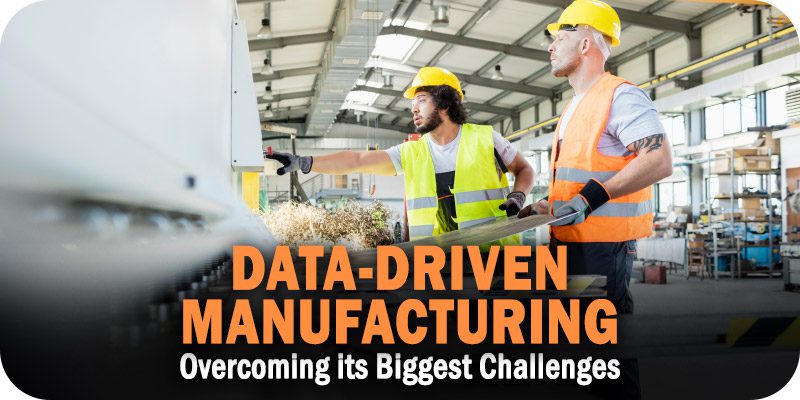Overcoming the Biggest Challenges for Data-Driven Manufacturing


As part of Solutions Review’s Contributed Content Series—a collection of articles written by industry thought leaders in maturing software categories—Parth Joshi, the Chief Product and Technology Officer of Hexagon’s Manufacturing Intelligence division, explains how companies can overcome the challenges commonly associated with data-driven manufacturing initiatives.
Today’s manufacturing industry faces several opportunities and challenges. Out of all technology sub-segments, the manufacturing industry is probably one that has the most promise to go digital. Digitalization is often treated as the objective in manufacturing, but it’s not: it’s a tool rather than a goal. The reality is that digitalization can be the enabler for so many challenges facing manufacturers today, from IoT improving productivity to Artificial Intelligence that enables data-driven manufacturing insights.
Fear of change and an unknown future always holds us back. But as Alan Kay, the famous computer scientist, said: “The best way to predict the future is to create it.” Large, mature companies understand that taking risks is key to driving growth. However, the pace of change is still slow, favoring the tried and tested approaches, even while the market shifts around them and those approaches become increasingly less suited. Even if there is a desire to innovate, progress and implementation are naturally much slower because of the legacy systems large companies often rely on.
This is where advanced manufacturing technology adds its value. However, common concerns in manufacturing revolve around potential design, production, and quality gaps. Specialists will work on their structure areas without necessarily predicting what the manufacturing experts need or how those tweaks will affect the final physical part’s efficiency, cost, or function. Developing domain-specific data is the secret to making much better choices and improving manufacturing profit and sustainability.
COVID-19 has essentially altered the nature and priority of digitalization in manufacturing. Our industry has learned many hard lessons. The challenges in harnessing data between production stages have been a known issue for decades, but the pandemic and ongoing supply chain standstill exposed those issues on a macro level. Manufacturing giants are changing their thinking to be resilient against future challenges. We know of several large companies revisiting how they would approach problems if they did not have legacy processes, infrastructure, and tools and work backward from that. That’s how to arrive at the best solution most quickly.
Take aerospace, for example. Despite cutting-edge innovation in design and engineering, it has a lower total volume and variety of products, which has resulted in it being far slower to adopt automation practices than other industries, relying instead on a high degree of human labor.
However, this approach is not scalable, and current predictions suggest that if the industry is to keep up with consumer demand, it needs to double in the next 20 years and do so while complying with green regulations. The pressures this is putting the industry under have sparked more innovation over the past few years than in the previous five decades: from making drones, electric vertical take-off and landing (eVTOL), or hydrogen-powered aircraft to applying composites, 3D printing, and AI.
Widget not in any sidebars
AI and Machine Learning (ML) are critical in making data-driven manufacturing a strategy capable of solving complex problems and moving the industry forward. Manufacturers produce reams of data throughout the product design and production workflow and receive it in every form possible, including simulation data, operating machine data, and quality measurement data.
These datasets are helpful as isolated observations and help inform their respective processes but are extremely challenging, if not impossible, to connect into holistic insights across the product lifecycle. This results in these siloes between technical specialisms and supply chains. But an integrated view of the design to manufacturing is required to develop future projects.
Digital twins, integrated with a metaverse-like collaboration platform, are how we see those AI insights best harnessed in the future. They are virtual representations of physical entities that can be tested, prototyped, and iterated at low running costs and with high accuracy. They ultimately help underpin the needed growth in manufacturing. The metaverse would enable the iterative process of engineering to be streamlined, considering multiple changes simultaneously. The more accurate and specific data provided to an AI solution, its outputs are more valid. This, in turn, will improve efficiencies for companies down the line.
Optimizing computing efficiencies through AI enables the data-driven insights that make this virtual world both possible and valuable, an immersive experience that will be critical for manufacturers. Platforms like this are ultimately designed to carry forward the lessons learned from the supply chain disruption and pressures. This allows manufacturers to build agile and resilient processes to respond positively to change, take advantage of new opportunities, create faster product pathways, and develop increasingly autonomous workflows.
This is an excellent time for manufacturers and manufacturing to innovate. There are still many challenges to overcome for the industry to understand and harness the potential of data. Still, we believe we are looking at a new era in manufacturing productivity. Connected devices and systems could radically alter the very nature of manufacturing, offering new opportunities for fine-grained control, reduction of waste and overengineering, and facilitation of design, to name a few.
While implementing this strategy has to be evolutionary and consider existing installations, data will be pivotal in taking manufacturing to the next level. It will enable solutions for full-lifecycle problems, like sustainability, by providing global design and production optimization. Simply put, data-driven manufacturing will be the key to developing safer and greener products, ultimately benefiting us all.

























